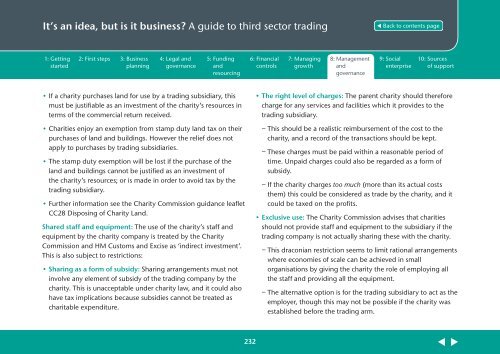A guide to third sector trading - WCVA
A guide to third sector trading - WCVA
A guide to third sector trading - WCVA
You also want an ePaper? Increase the reach of your titles
YUMPU automatically turns print PDFs into web optimized ePapers that Google loves.
It’s an idea, but is it business? A <strong>guide</strong> <strong>to</strong> <strong>third</strong> sec<strong>to</strong>r <strong>trading</strong><br />
1: Getting<br />
started<br />
2: First steps 3: Business<br />
planning<br />
4: Legal and<br />
governance<br />
5: Funding<br />
and<br />
resourcing<br />
6: Financial<br />
controls<br />
7: Managing<br />
growth<br />
8: Management<br />
and<br />
governance<br />
9: Social<br />
enterprise<br />
10: Sources<br />
of support<br />
• If a charity purchases land for use by a <strong>trading</strong> subsidiary, this<br />
must be justifiable as an investment of the charity’s resources in<br />
terms of the commercial return received.<br />
• Charities enjoy an exemption from stamp duty land tax on their<br />
purchases of land and buildings. However the relief does not<br />
apply <strong>to</strong> purchases by <strong>trading</strong> subsidiaries.<br />
• The stamp duty exemption will be lost if the purchase of the<br />
land and buildings cannot be justified as an investment of<br />
the charity’s resources; or is made in order <strong>to</strong> avoid tax by the<br />
<strong>trading</strong> subsidiary.<br />
• Further information see the Charity Commission guidance leaflet<br />
CC28 Disposing of Charity Land.<br />
Shared staff and equipment: The use of the charity’s staff and<br />
equipment by the charity company is treated by the Charity<br />
Commission and HM Cus<strong>to</strong>ms and Excise as ‘indirect investment’.<br />
This is also subject <strong>to</strong> restrictions:<br />
• Sharing as a form of subsidy: Sharing arrangements must not<br />
involve any element of subsidy of the <strong>trading</strong> company by the<br />
charity. This is unacceptable under charity law, and it could also<br />
have tax implications because subsidies cannot be treated as<br />
charitable expenditure.<br />
• The right level of charges: The parent charity should therefore<br />
charge for any services and facilities which it provides <strong>to</strong> the<br />
<strong>trading</strong> subsidiary.<br />
− This should be a realistic reimbursement of the cost <strong>to</strong> the<br />
charity, and a record of the transactions should be kept.<br />
− These charges must be paid within a reasonable period of<br />
time. Unpaid charges could also be regarded as a form of<br />
subsidy.<br />
− If the charity charges <strong>to</strong>o much (more than its actual costs<br />
them) this could be considered as trade by the charity, and it<br />
could be taxed on the profits.<br />
• Exclusive use: The Charity Commission advises that charities<br />
should not provide staff and equipment <strong>to</strong> the subsidiary if the<br />
<strong>trading</strong> company is not actually sharing these with the charity.<br />
− This draconian restriction seems <strong>to</strong> limit rational arrangements<br />
where economies of scale can be achieved in small<br />
organisations by giving the charity the role of employing all<br />
the staff and providing all the equipment.<br />
− The alternative option is for the <strong>trading</strong> subsidiary <strong>to</strong> act as the<br />
employer, though this may not be possible if the charity was<br />
established before the <strong>trading</strong> arm.<br />
232












